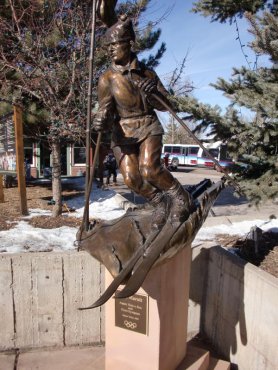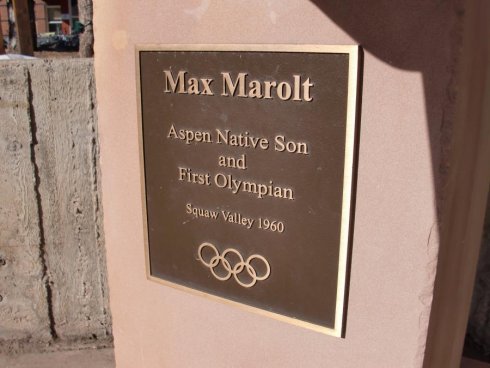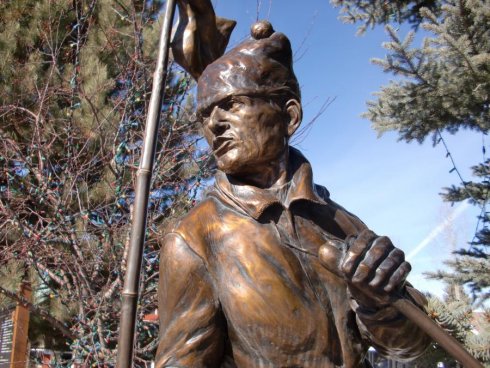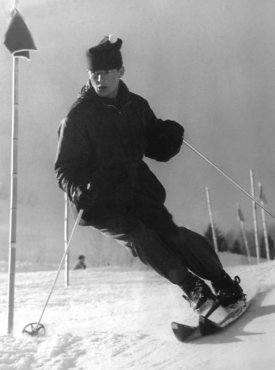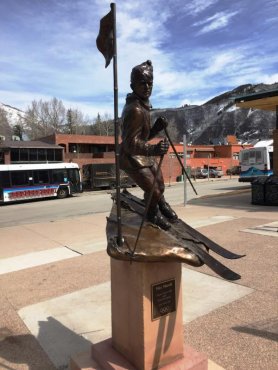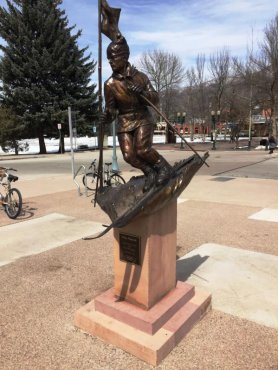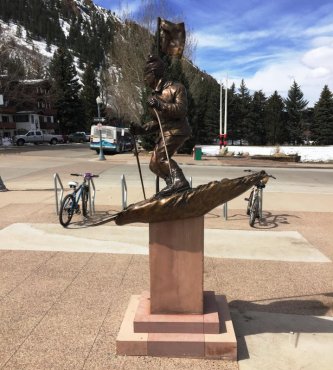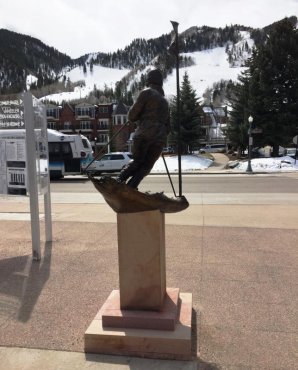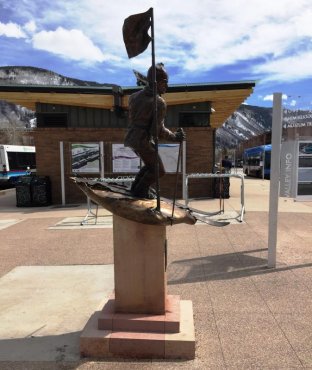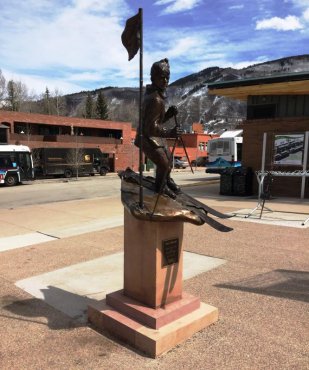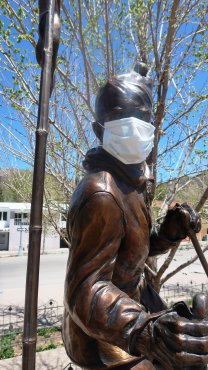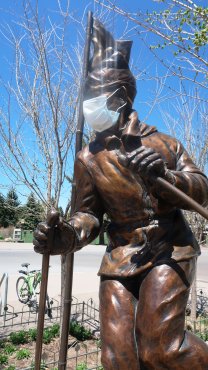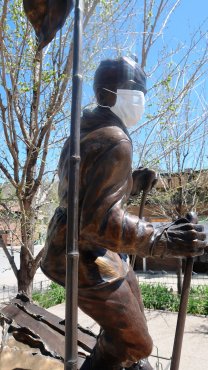The Max Marolt Statue (Aspen Mountain)
Although the Max Marolt statue is not on Aspen Mountain, it is close enough that the author felt it appropriate to include it on this web site. It is located on the site of the Rubey Park Transit Center.
Max Marolt was Aspen's first Olympian. He was born in 1936 and died in 2003. The statue was crafted by local artist Susan Olsen in 2004 and cost $18,000. Beneath the statue is a plaque which states:
Max Marolt
Aspen Native Son and
First Olympian
Squaw Valley 1960
Max Marolt dies on ski trip
By Jennifer Davoren
Aspen Times Staff Writer
Max Marolt — an icon of skiing and politics in Aspen — died Saturday, July 26, after suffering a heart attack while skiing in Argentina. Marolt, 67, was making his final run of the day at Las Leñas ski resort when the heart attack struck. He died doing what he loved, his family said. "In general, his love of the sport of skiing" will always be remembered, said his son, Mike. "He told me about a year ago that he loved skiing more now than he had in his whole life." Max Marolt was born in 1936 in Aspen, the second of three sons born to Bill and Celia Marolt. The Marolts were familiar faces in the skiing community — all three boys, Bud, Bill and Max, were there the day the Aspen Mountain ski lift first opened to the public. The brothers were also some of the first to join Aspen's fledgling junior racing team. Marolt was one of Aspen's most promising young skiers. In 1951, a team led by Marolt and Dave Stapleton made the trip to the National Junior Meet in Stowe, Vt. Marolt captured third place and went on to join the ski team at Denver University. Using breakneck speed and startling skills, he earned a place on the U.S. Ski Team in 1954. Four years later, a daring run in the FIS Championships led to an invitation to the 1960 Olympic Games in Squaw Valley, Calif. The 24-year-old Marolt didn't fare as well as he had hoped, placing 15th overall in the downhill and giant slalom. Still, as the first Aspenite to compete in the Olympic Games, he paved the way for dozens of locals with dreams of gold medals. Marolt's younger brother, Bill, became the second Aspenite to compete with a trip to the 1964 Winter Olympics. Though Marolt enjoyed skiing daunting peaks around the world, Aspen remained his home. He became a sales rep for several ski equipment manufacturers. He and his wife, Betty, raised their four children — daughter Marlis, and sons Roger, Steve and Mike — here, and helped foster their ski careers. The twins, Steve and Mike, also became adventurous skiers and recently returned from a summit attempt on Mount Everest. Marolt was sidelined by a heart attack once before, his family recalled. In June 1975, his wavering health forced him to give up his seat on the Pitkin Board of County Commissioners after five months in office. He won a seat on the Aspen City Council in 1995 and ran for mayor in 1997, losing to incumbent John Bennett. Max and Betty celebrated their 43rd wedding anniversary earlier this month with a visit from their entire family. The group had planned to get together again in October, when Marolt will be inducted into the Colorado Ski Hall of Fame.
Max Marolt loved to ski. He loved to ski a lot. In fact, the only things he loved more than skiing were his wife, his kids and his grandchildren. If he wasn't gathered around a table for a good meal with his family, spending time with Betty, or playing with the youngest Marolts in the back yard, he wanted to be sliding down a mountain. It didn't matter if the snow was drifted into slabs, rock hard ice or rotten slush. To Max, the conditions were always super. I guess this is not too surprising for a kid born in Aspen in 1936. The ghost town didn't have much else to offer. Skiing was a way to get out. And get out he did. He strapped on his first pair of skis shortly after he could walk and rode them around the globe several times, stopping along the way to compete in a couple of World Championships and the 1960 Winter Olympics in Squaw Valley, Calif. The regret of not winning a medal there nearly ruined it for him. The broken dream was tough to let go. But, despite this disappointment, he couldn't get it out of his blood. There were too many good memories there. Like the time he was in Aleyeska, Alaska. Some locals in a bar told him nobody could ski the imposing peak looming above town. They didn't know Max. The first pitch was so steep that he more dropped from it than skied it. He lit at the bottom and bent both skis into reverse camber. He descended the rest of the way on those bent skis only to discover that the locals that made the bet didn't have the money to pay up. He exacted a bigger price: that mountain still bears his name. It wasn't all easy, though, and Max's skiing days almost came to an untimely end. A massive heart attack nearly killed him during the early years of raising his family. I think he made a deal with God back then. He begged the Lord to let him say a proper goodbye to his family and have one last ski run. He swore he would give up smoking, drinking and working so darn hard. Well, God acquiesced and then spent the next 30 years chasing him. The doctors called him their miracle patient. He made good on all his promises and showed his family how much he loved them every chance he got. Disease had taken one third of his heart, but he spent the rest of his life giving what was left of it away. And, he kept on skiing. Toward the end, I think Max somehow sensed that God had finally caught up with him. He also knew that he couldn't fool God into granting him one last run again. So as God stopped for a moment to catch his breath, Max took the opportunity to finish two last pieces of business. First, he made reservations to go down to South America. Then he celebrated his 43rd wedding anniversary with Betty in early July. All his children were there. His daughter Marlis and her husband John made the trip from California. The grandkids teased him and made him laugh. The whole family got together several more times in the ensuing days. Max was as happy as anyone had ever seen him. He told Betty that he was proud of what they had accomplished together. A week later Max got on a plane headed for winter. He arrived at the ski area late in the day, but wanted to make sure he got in one run before the lifts closed. He made a couple of turns before God welcomed him into his arms at last. Max made one last run after all. The day his heart finally gave way, a part of my heart broke forever. I will miss him dearly now as I wait in the late winter afternoons for him to come flying around the corner at the bottom of Lift 1A to ride up with me for one last run. The shadows of Aspen Mountain will seems a bit longer now. But if heaven is anything it's cracked up to be, you can bet that Max is taking a couple of runs today. I love you dad. Thanks for everything. Save some powder for the rest of us.
************************************************************
This article appeared in the Aspen Times on September 30, 2003: Aspen’s Marolt to be inducted into Ski Hall of Fame.
By Jennifer Davoren, Aspen Times Staff Writer
The Colorado Ski Hall of Fame will posthumously honor Max Marolt of Aspen on Oct. 18 during its 27th annual induction ceremony. Marolt, who died in July at the age of 67 while on a ski trip to Chile, witnessed Aspen’s birth as a ski town. He saw the opening of the town’s first ski lift, and was one of the first to sign up for the local junior ski racing team. Between 1951 and 1960, Marolt skied at the National Junior Meet; joined the ski team at Denver University and competed in the Olympic Games and the FIS Championships. He also created the West’s first regional ski repair and service center in Aspen in the late ’60s. Marolt received news of his Hall of Fame induction shortly before his death, said his son, Steve. Marolt responded “like any athlete – to get that recognition, and to be included with people of that caliber – was exciting,” Steve said. Marolt’s brother, Bill; his wife, Betty; four children, Marlis, Roger, Mike and Steve; and his grandchildren plan to attend the ceremony. After viewing a video highlighting Marolt’s many slopeside accomplishments, his children will speak to ceremony attendees. The induction will be a bittersweet occasion for Marolt’s nearest and dearest, but one they wouldn’t miss for the world. “It’s going to be an extremely hard evening for the family to get through, but it’s awesome, too,” Steve Marolt said. Marolt is one of five men – and one of three men with ties to Aspen – to be honored at the ceremony. The Hall of Fame will also welcome Colorado natives Kevin Delaney, Frank Penney, Morrie Shepard and Park Smalley during the induction ceremony.... https://www.aspentimes.com/news/aspens-marolt-to-be-inducted-into-ski-hall-of-fame/
******************************************************
See this article about the creation of the statue, which appeared in the Aspen Journal/Aspen Daily News Online on July 27, 2004: "Statue of Aspen skiing legend takes shape," by Thomas Watkins.
"Slowly but surely, a statue commemorating the late Aspen skiing legend Max Marolt is taking shape in a studio at the Red Brick Center for the Arts. Known as a maquette, a foot-high version of the statue has been crafted by local artist Susan Olsen. The miniature is a scaled-down prototype of what will eventually be a three-quarter sized bronze sculpture of Aspen's first Olympian, who died last year after suffering a heart attack while skiing at Las Leñas in Argentina. The process of creating a bronze sculpture is a time-consuming one, said Olsen, who estimates it will take about a year from start to completion. The statue was commissioned earlier this year by Marolt's son, Mike, and Aspen City Council agreed to contribute $5,000 to help pay for the statue, which will cost a total of $18,000. Olsen said that the most challenging task so far has been capturing the movement of Marolt - the sculpture is of the skier carving a turn around a slalom pole. "It's very hard, I'll tell you," said Olsen, 58, who taught art for much of her career but about eight years ago started sculpting for a living. "I keep getting my older friends over here that have actually skied in the style of Max Marolt. We have to make sure the pose is right." She added that attaining a facial likeness is difficult when working only from a photograph. Once she has gotten final approval for the maquette, Olsen will then sculpt the full-sized version of the statue, which will be about 51-inches tall. She said that she will use an oil-based clay, which will be shipped to a foundry in Paonia. Workers at the foundry will then carry out the final steps of the process, including an elaborate series of molds that will be made for several parts of the statue. These must then be welded together, the joints between them buffed and a final patina applied to the bronze. When all that is done, the statue will be mounted on a stone base, which will probably about 48-inches tall. Mike Marolt said that he hopes the bronze will become the first in a larger collection of statues commemorating all of Aspen's Olympians. Although such a collection has yet to be approved, a Skier Walk of Fame connecting some of the hotels along the base of Aspen Mountain is something that is being explored at a conceptual level by the city of Aspen. "I think it's a great idea to have a walkway (commemorating Aspen's skiers) at the base of some of the most famous mountains in the world," he said. Aspen Mayor Helen Klanderud said she supports such a walk of fame. "There's a marvelous opportunity for a walkway," she said. Donations to help pay for the statue can be sent to the Max Marolt Memorial Fund, c/o Mike Marolt, 230 S. Mill Street, Aspen 81611. Thomas Watkins can be reached at thomas@aspendailynews.com."
This item is part of a Facebook photo album that covers various signs and plaques on Aspen Mountain (you do not need to have a Facebook account in order to view the album): https://www.facebook.com/media/set/?set=a.451981024873867.101778.100001859201674&type=1&l=9577c13e9e
Photos of the statue and plaque appear in several sections below. Credit for the last photo in the first photo section below (which appears to be the photo used as a model for the statue) goes to the Colorado Ski Museum--Ski and Snowboard Hall of Fame.
If you have any photos of or information about this item that you would like to share for use on this page, please send to the author at AspenShrines@aol.com.
********************************************************
Click on images to enlarge.
**********************************************************
In 2015 the Rubey Park Transit Center was updated and enlarged. Before that happened, the statue was located on the East end of the property; as part of the project, the statue was moved to the West end of the property. Below are photos of the statue taken on March 28, 2016, showing it in its new location.
***************************************************
The photos in the section below were taken in May of 2020. Max appears to be wearing a COVID-19 face mask (which were required to be worn in Aspen around that time). Click on images to enlarge.
